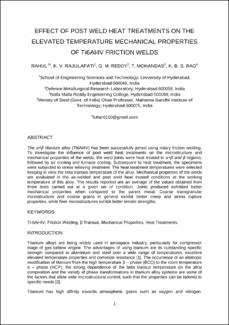| dc.contributor.author | Rahul, Rahul | |
| dc.contributor.author | Rajulapati, KV | |
| dc.contributor.author | Reddy, GM | |
| dc.contributor.author | Mohandas, T | |
| dc.contributor.author | Rao, KS Jagannatha | |
| dc.date.accessioned | 2020-06-16T03:29:08Z | |
| dc.date.available | 2020-06-16T03:29:08Z | |
| dc.date.issued | 2018-02-09 | |
| dc.identifier.uri | http://repositorio-indicasat.org.pa/handle/123456789/75 | |
| dc.description | The {\alpha}+\b {eta} titanium alloy (Ti6Al4V) has been successfully joined using rotary friction welding. To investigate the influence of post weld heat treatments on the microstructure and mechanical properties of the welds, the weld joints were heat treated in {\alpha}+\b {eta} and\b {eta} regions, followed by air cooling and furnace cooling. Subsequent to heat treatment, the specimens were subjected to stress relieving treatment. The heat treatment temperatures were selected keeping in view the beta transus temperature of the alloy. Mechanical properties of the welds are evaluated in the as-welded and post weld heat treated conditions at the working temperature of this alloy. The results reported are an average of the values obtained from three tests carried out at a given set of condition. Joints produced exhibited better mechanical properties when compared to the parent metal. Coarse transgranular microstructure and coarse grains in general exhibit better creep and stress rupture properties, while finer microstructures exhibit better tensile strengths | en_US |
| dc.description.abstract | The {\alpha}+\b {eta} titanium alloy (Ti6Al4V) has been successfully joined using rotary friction welding. To investigate the influence of post weld heat treatments on the microstructure and mechanical properties of the welds, the weld joints were heat treated in {\alpha}+\b {eta} and\b {eta} regions, followed by air cooling and furnace cooling. Subsequent to heat treatment, the specimens were subjected to stress relieving treatment. The heat treatment temperatures were selected keeping in view the beta transus temperature of the alloy. Mechanical properties of the welds are evaluated in the as-welded and post weld heat treated conditions at the working temperature of this alloy. The results reported are an average of the values obtained from three tests carried out at a given set of condition. Joints produced exhibited better mechanical properties when compared to the parent metal. Coarse transgranular microstructure and coarse grains in general exhibit better creep and stress rupture properties, while finer microstructures exhibit better tensile strengths | en_US |
| dc.language.iso | en | en_US |
| dc.subject | titanium | en_US |
| dc.subject | Ti6Al4V Friction Welds | en_US |
| dc.title | Effect of Post Weld Heat Treatments on the Elevated Temperature Mechanical Properties of Ti6Al4V Friction Welds | en_US |
| dc.type | Article | en_US |

